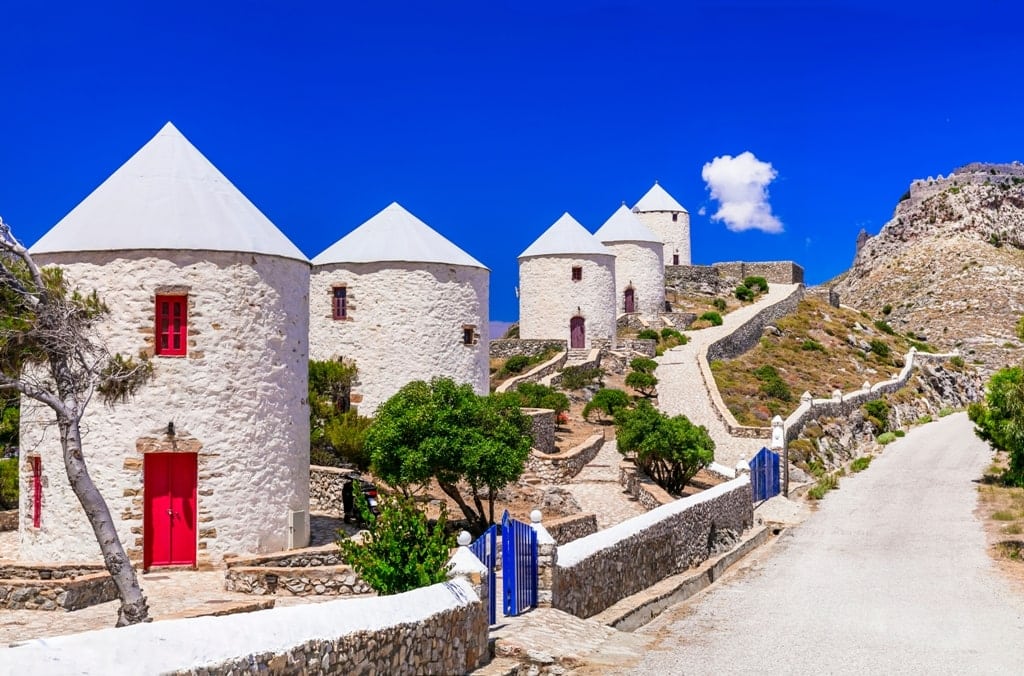If you are looking not only for the trademark beauty and tradition of the Greek islands but also for authenticity, calmness, and fewer tourist crowds, then Leros might be the perfect island for you.
Leros is one of the lesser-known islands of the Dodecanese- for now! Known to the locals and the connoisseurs as an island that strikes the perfect balance between tradition and modernity, relaxation and fun, lush nature, and wild landscapes, Leros has something for everyone.
To make the most out of this gem of an island and unforgettable, awesome holidays, here is a guide with everything you should know about Leros to fully enjoy it.
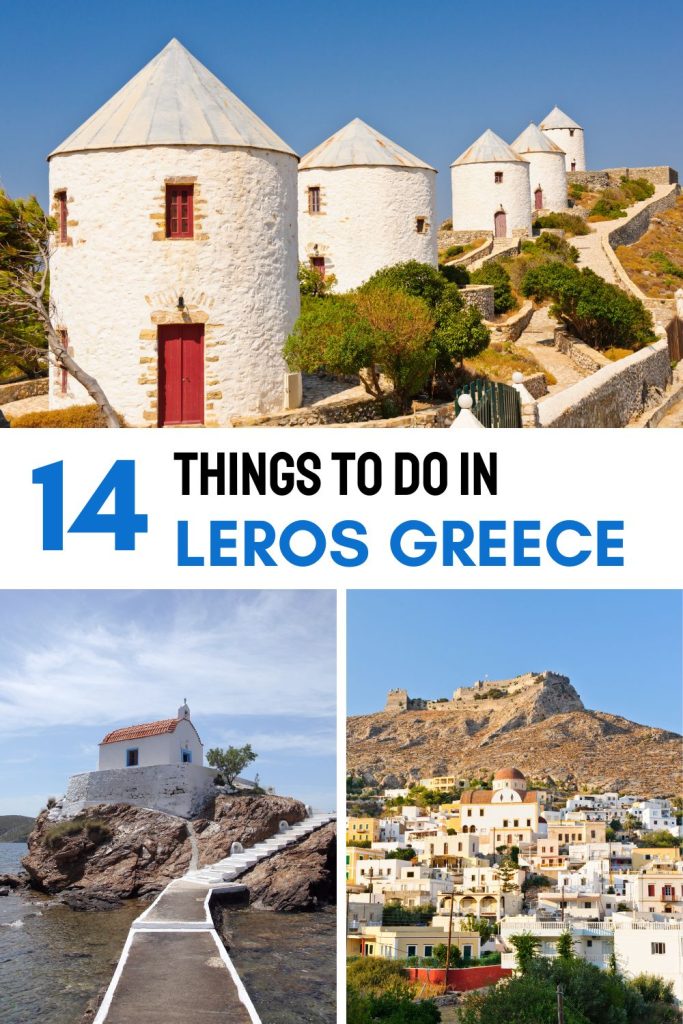
Disclaimer: This post contains affiliate links. This means I will receive a small commission if you click on certain links and subsequently purchase a product.
- Where is Leros?
- How to get to Leros
- A Brief History of Leros
- Things to Do in Leros
- Explore Aghia Marina
- Explore Panteli village
- Visit the Castle of Panteli (Our Lady’s Castle)
- Explore Lakki village
- Visit the Temple of Artemis
- Hit the museums
- Visit the churches
- Hit the beaches
- Take a day trip to Lipsi Island.
- Sample the local food and specialties
- Do some scuba diving.
- Get on an e-bike
- Go hiking
- Taste the local wine
Where is Leros?
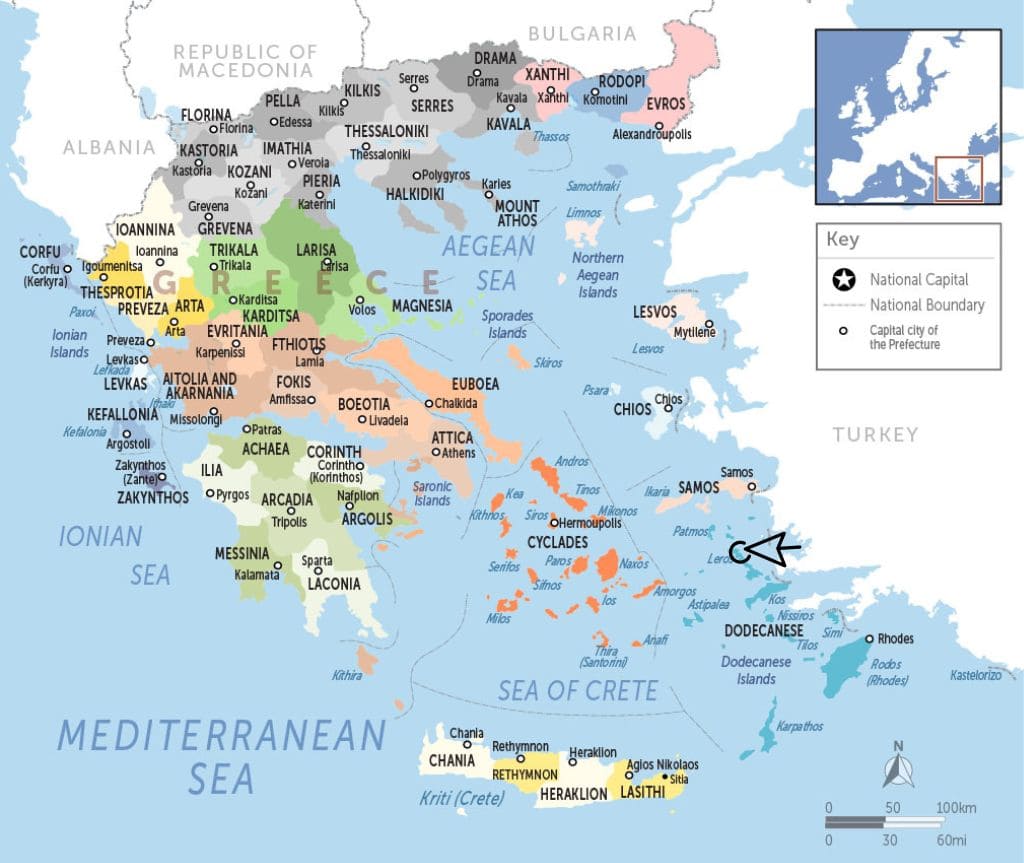
Leros is situated in the Dodecanese group of islands in the southeast part of the Aegean Sea. Right between the islands of Patmos, Kalymnos, and Lipsi, it is just opposite the Turkish coastline. It is not very large, but it is very lush with nature and very fertile, with gentle hills and usually good weather.
The best time to visit is during the summer season, roughly from early May to late September. Peak tourist season is the months of July and August, so expect prices to be the highest then.
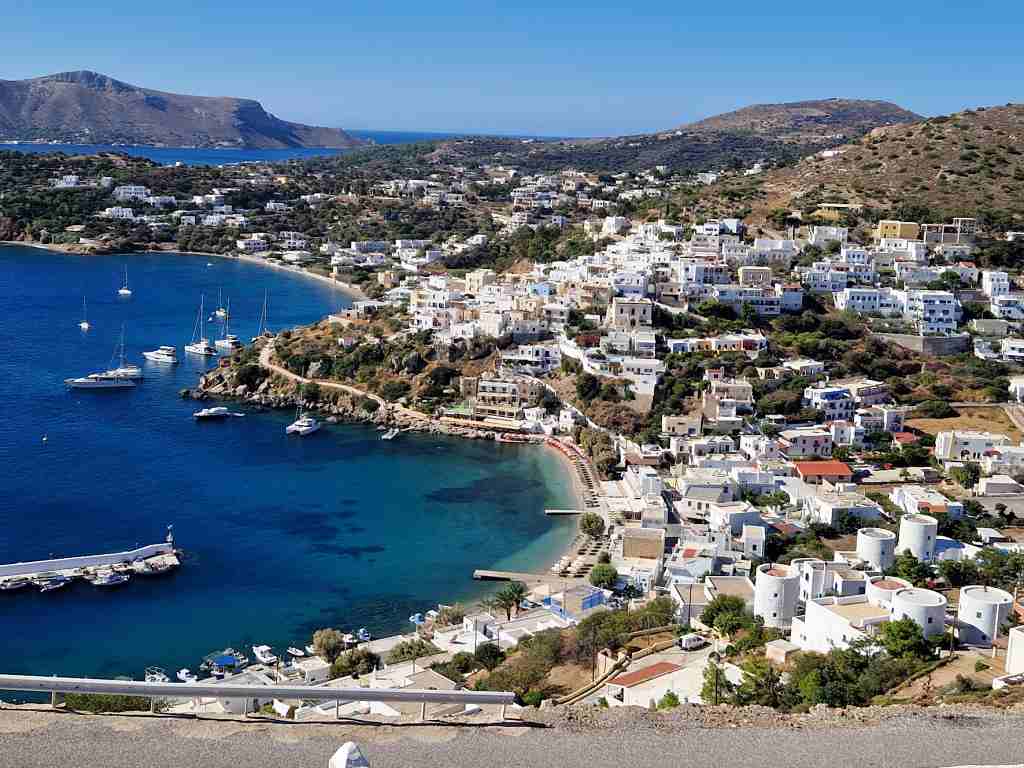
Consider booking your vacation for September to get the best out of everything: all amenities and venues are still open as it’s still the tourist season, but most of the crowds are gone since school begins in September in Greece. The sea is still quite warm, and the summer heat is mellow.
How to get to Leros
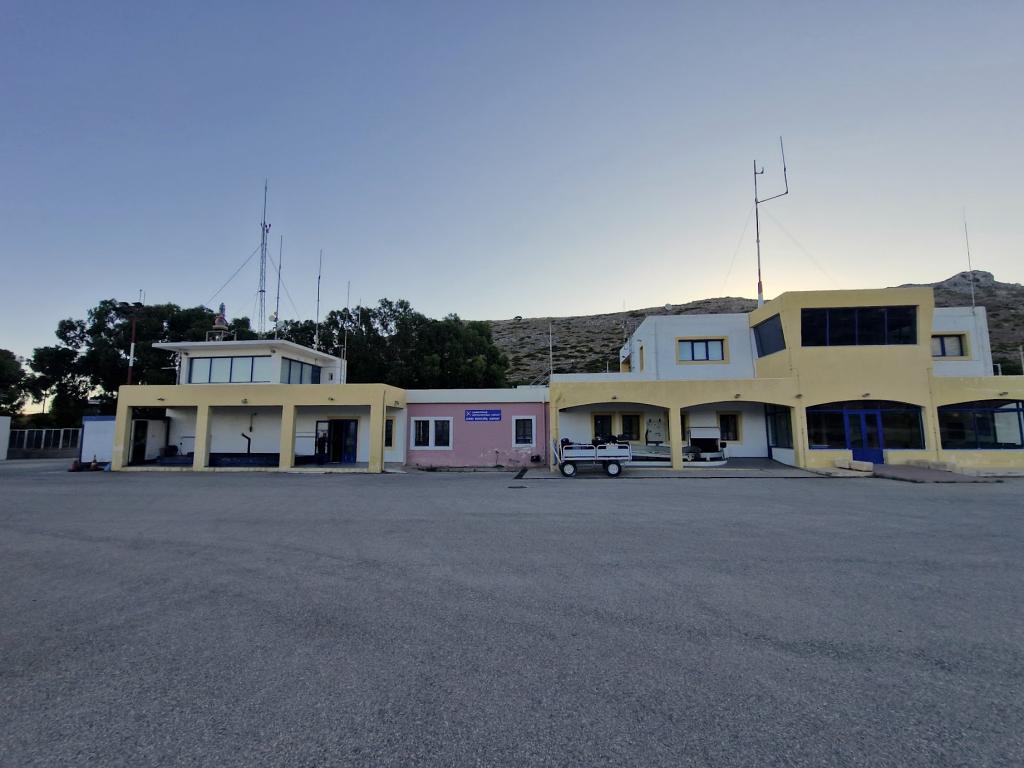
You can travel to Leros by ferry or plane, as it has a domestic airport. The airport is 6 km from Leros’ Chora, Aghia Marina.
If you choose to go by plane, you can get a flight to Leros from Athens Airport, Eleftherios Venizelos. The flight lasts roughly 50 minutes. There is a taxi service to use once you arrive at Leros airport, but no bus service.
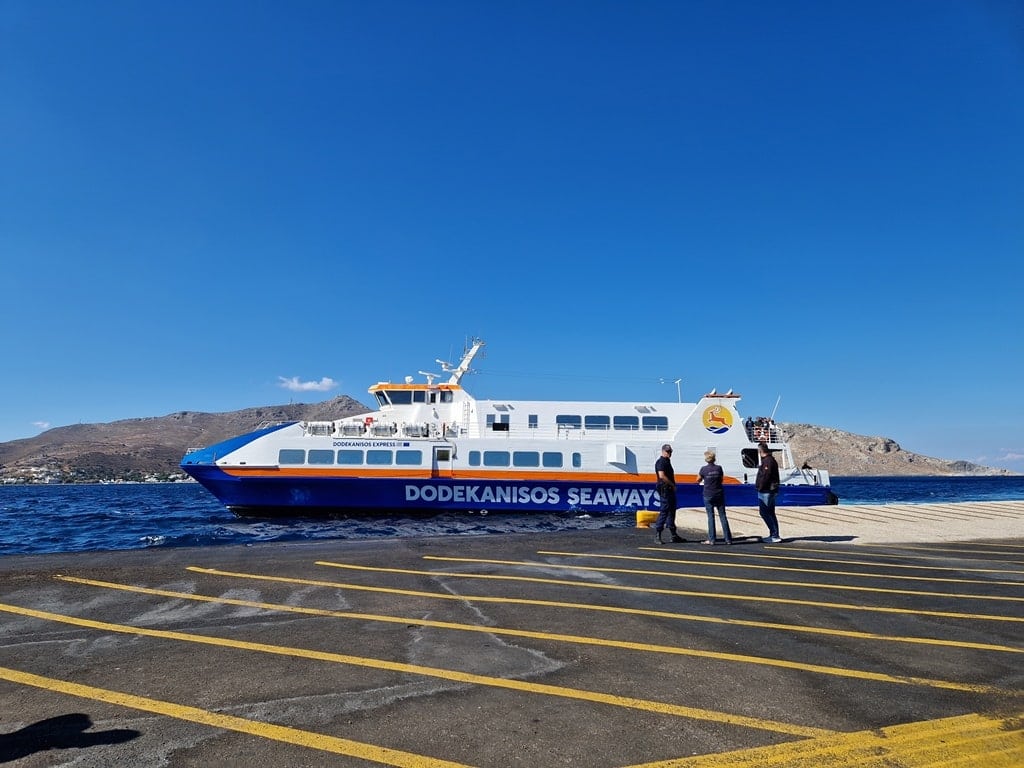
If you opt to go by ferry, you can catch one from Piraeus. You must make sure to book in advance because the ferry to Leros leaves only 4 times a week, rather than daily, and the trip lasts 8 hours. A cabin is ideal if you decide to travel that way.
If none of the above direct options fit your schedule, you can also travel to Kos, Rhodes, Patmos, Kalymnos, or Lipsi instead and then catch a ferry to Leros from there. Ferries between the islands of the Dodecanese run daily and frequently. Kos, Kalymnos, and Rhodes also have airports to shorten your travel time if you decide to go that route.
Click here for the ferry schedule and to book your tickets directly.
or enter your destination below:
A Brief History of Leros
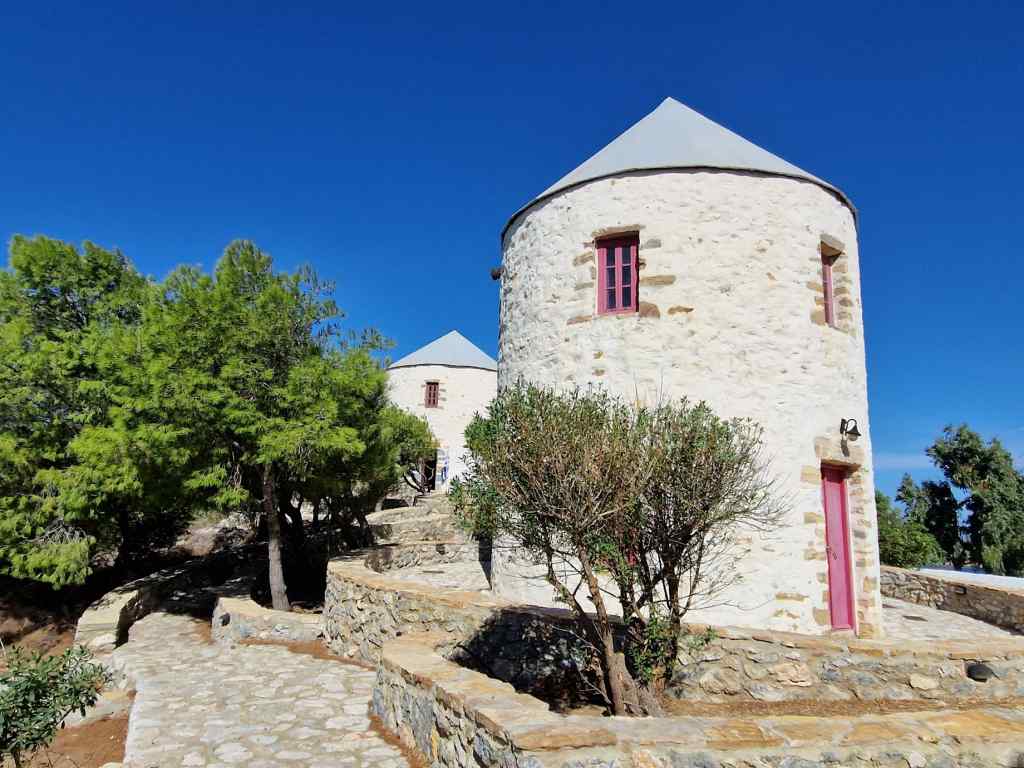
According to the Ancient Greeks, Artemis, the goddess of the hunt and moon, favored Leros and claimed the island as her own. She would often hunt in Leros’ lush forests and lounge there with her retinue of loyal virgin followers.
That’s why there have been shrines and temples to Artemis on the island since early antiquity and a famous sanctuary. Historically, there is evidence that the island has been continually inhabited since the Neolithic era.
Leros is mentioned much in Thucydides’ account of the Peloponnesian Wars, as Leros supported Athens. When the Athenians lost the war, Leros came under the rule of Sparta for a brief period. During the rise of Alexander the Great and the Romans, Leros came under their respective rule and later became part of the Byzantine Empire.
In the 1300s, Leros was occupied by the Venetians, who fortified the island against pirates and enemies. Two centuries later, in the 1500s, Leros was signed over to the Ottomans by the Genoese.
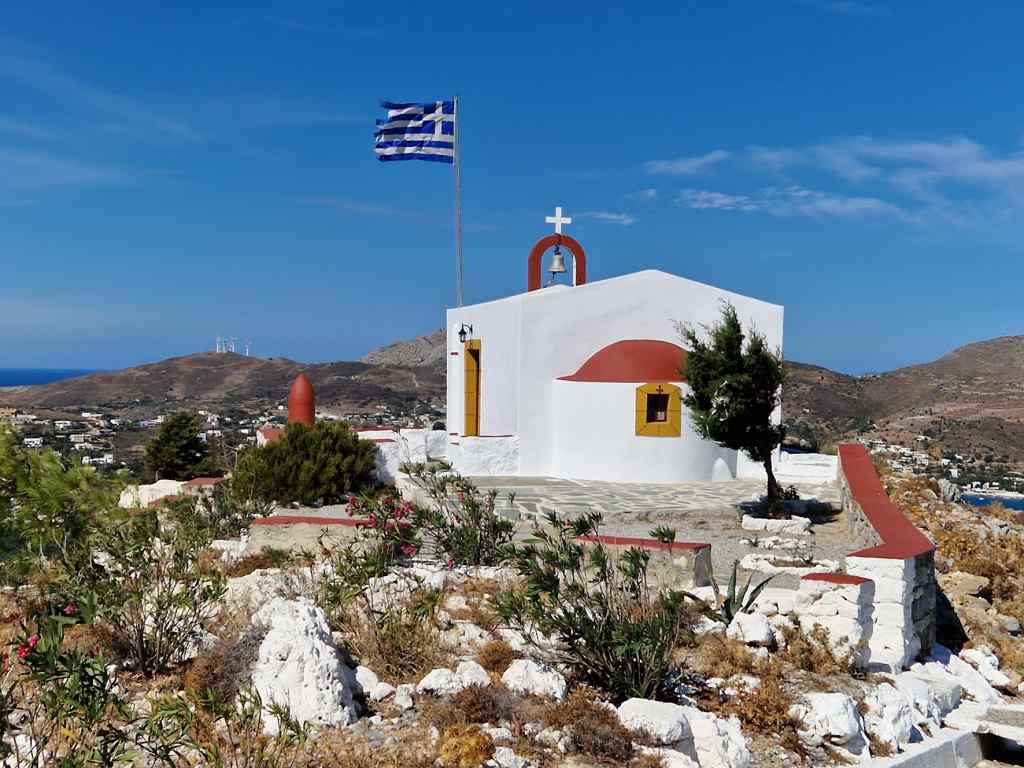
During the Turkish occupation, Leros enjoyed a privileged status. Though Leros rebelled and was freed in the Revolution of 1821 that founded the modern Greek state, the treaty of 1830 signed Leros over back to Turkey.
In 1912, however, the Italians took over Leros during the battles of the Lybian War with Turkey until 1919; finally, Leros was briefly returned to Greece before being retaken by the Italians in the Treaty of Lausanne. The Italians did their best to force the locals to adopt an Italian identity, making the Italian language compulsory and cracking down on Greek institutions.
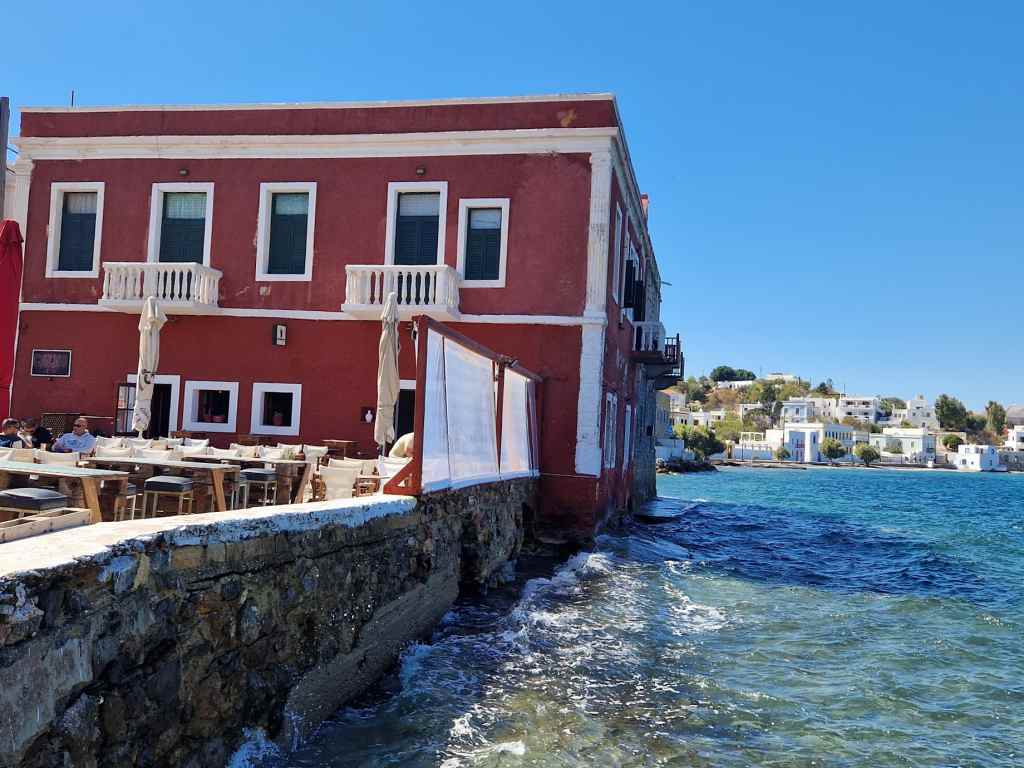
During WWII, since Leros was part of the Italian influence and considered of high strategic importance by Mussolini, it was bombed by the British.
When Italy joined the Allies against the Axis, the Germans were the ones that bombed Leros, while fierce naval battles took place in the nearby waters.
After the Germans lost the war, Leros came under British jurisdiction until 1948, when finally, it was permanently reunited with Greece along with the rest of the Dodecanese.
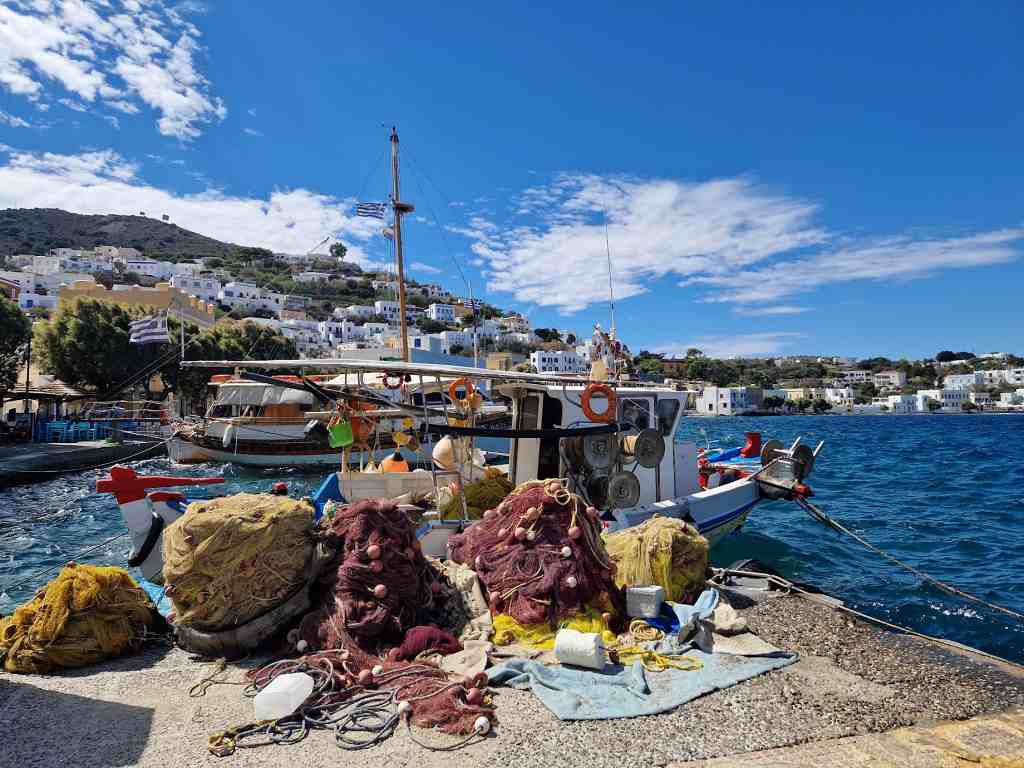
Post-war, Leros became famous as an exile island for political dissidents, especially during the Junta of 1967. The political prisoners were kept in the old Italian barracks. By the end of the Junta in 1974, around 4,000 prisoners had been incarcerated there.
Things to Do in Leros
Leros’ gorgeous landscape and rich, long, and tumultuous history make for several places to see and visit. But that is not all! There is exquisite food and wine to be sampled and many other activities to experience. Here is a short list of what you should not miss:
Explore Aghia Marina
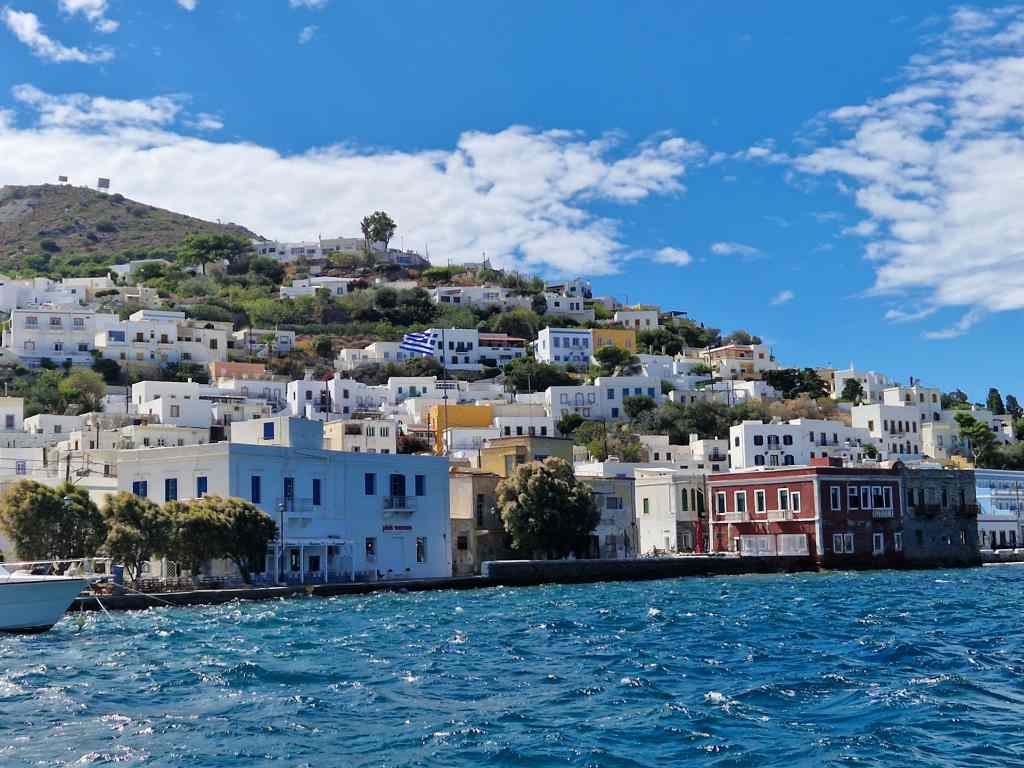
Though technically, Aghia Marina is Leros’ Chora, in reality, it is only one of three towns that make up the island’s capital. With Platanos being the main hub of the capital, Aghia Marina is where the port is.
It is also one of the most picturesque areas you will find, with traditional houses whitewashed with brightly colored shutters and doors, big imposing mansions of neoclassical style, and gorgeous winding pathways that are perfect for Instagram.
Explore the town and walk towards the port, where you will find the Byzantine fortress of Bourtzi. The castle is in ruins, but it still retains an element of force in the still-standing outer wall and the cistern within it. It also offers a great view of the entire port and the Aegean.
Explore Panteli village
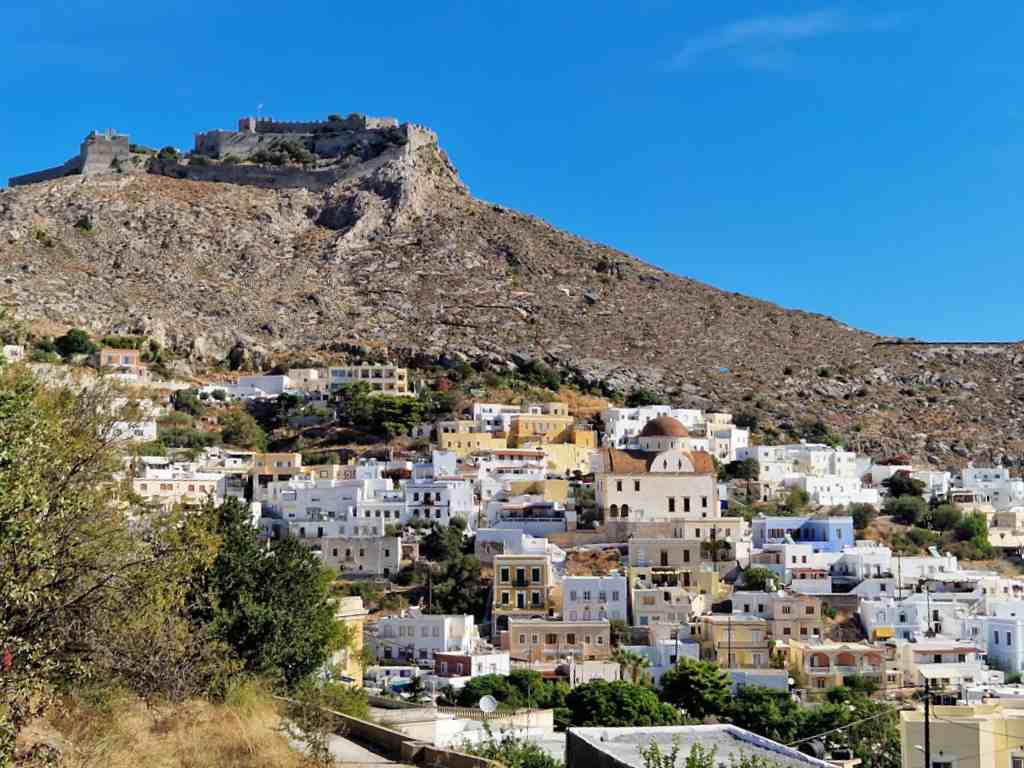
On the east side of Leros, you will find Panteli village. It is extremely picturesque, looking like an old painting just came to life: with the whitewashed houses, the bright windows, the fishing boats bobbing in the water, and the windmills reigning overhead, it would feel more like a movie set than a real place if it weren’t so authentic.
At Panteli, you will have the chance to explore, relax, and enjoy good food. The village is famous for its Castle and its small but beautiful sandy beach. It is also where everyone in Leros goes to have fresh fish on the grill! While at Panteli, visit the famous landmark of its windmills on your way to the castle.
Visit the Castle of Panteli (Our Lady’s Castle)
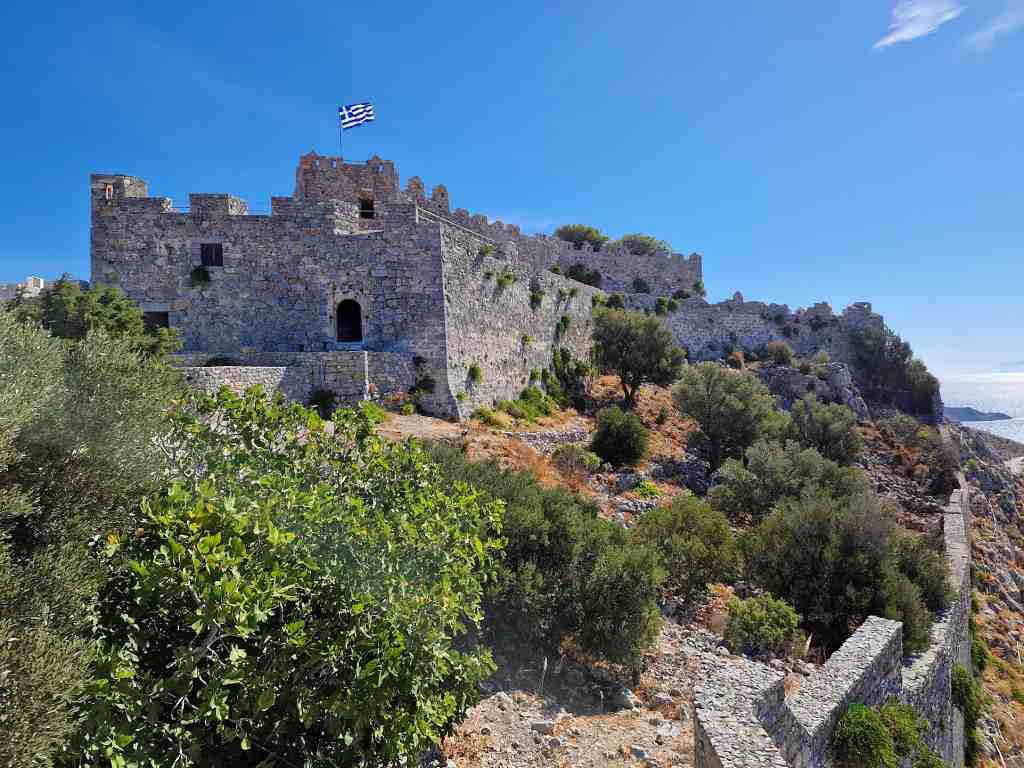
The imposing Castle of Panagia or Castle of Panteli was built by the Byzantines on the old location of the ancient Acropolis. The Castle of Panagia is one of the most important monuments from the Byzantine period, and several parts are well preserved. It has three yards and several churches.
It was also in constant use since the 11th century AD when it was completed, up until fairly recently. The Italians used it as an observation point in WWII, and later it was the basis for a Greek garrison guarding the island because of its proximity to Turkey. There is a small Ecclesiastical Museum and breathtaking views of the entire island to be enjoyed, so make sure to visit!
Explore Lakki village
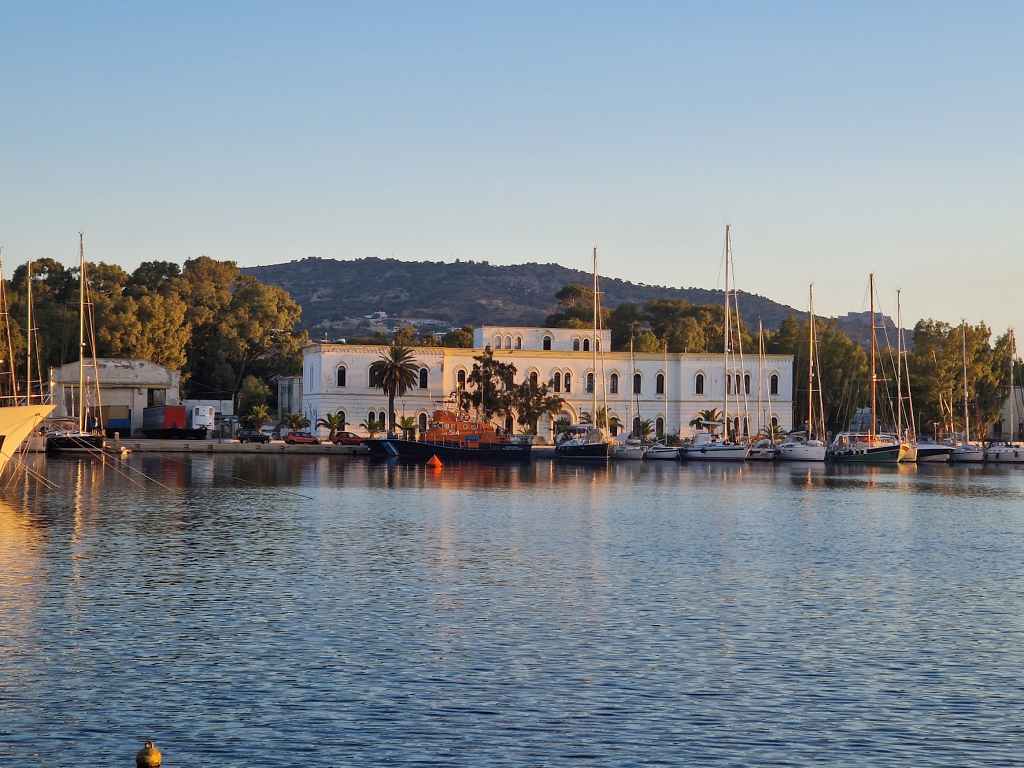
This could be one of the most unique villages in all of Greece because it defies most architectural norms and carries the stamp of a single, unique era of Leros’ history: the Italian war interim period of the 1920s and 1930s.
The entire town is built mainly in the Art Deco style, so much so that it’s said to have the highest percentage of such buildings after Miami, USA! Lakki has a big port, which Mussolini had overseen so that it would be able to support hydroplanes as well as other war vessels.
The town was built to be fascist Italy’s main administration hub for the island, and that’s why until recently, the locals had disdain for it. However, currently, it is being given the attention it deserves for its sheer architectural beauty, and you should explore it as a living, breathing open-air early 20th-century museum.
Visit the Temple of Artemis
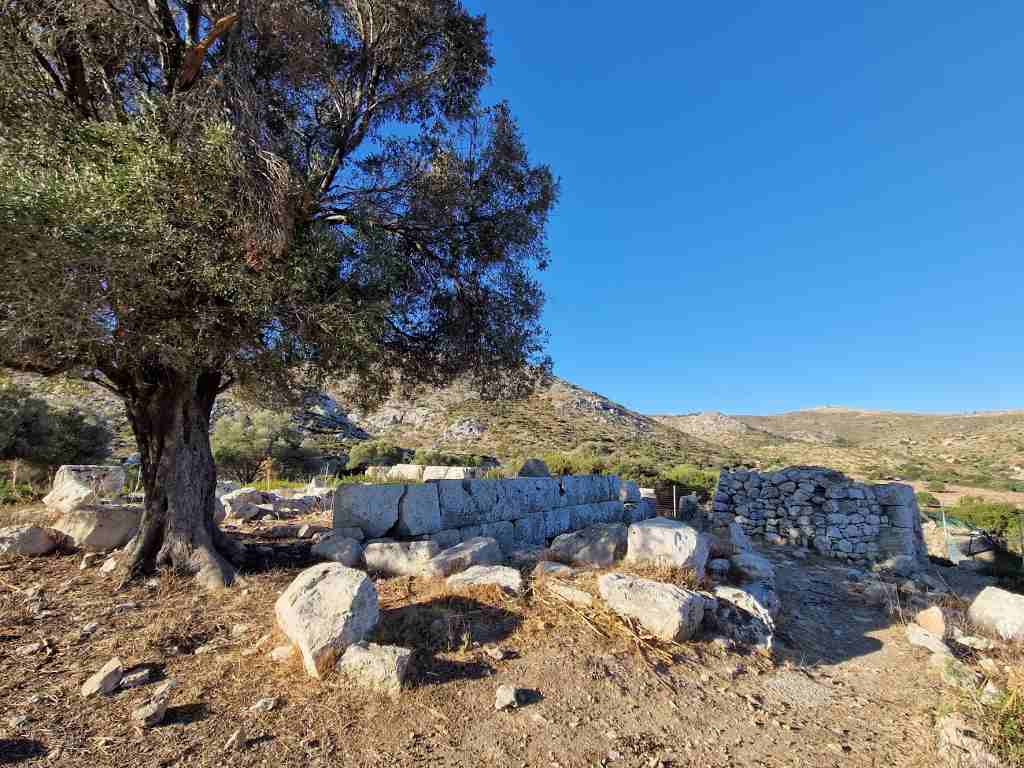
The temple of Artemis in Leros is very near the airport, and you can reach it by simply following the signs. You will find a peculiar structure that speaks to a historical practice: materials from ancient temples were recycled to build churches or housing.
This is what happened to the temple of Artemis, so what you will find are the remains of one of its walls and the ruins of a church made with the temple’s plaques and other building blocks. That’s why the site is marked as the “Ancient Tower, also known as the Temple of Artemis.”
Hit the museums
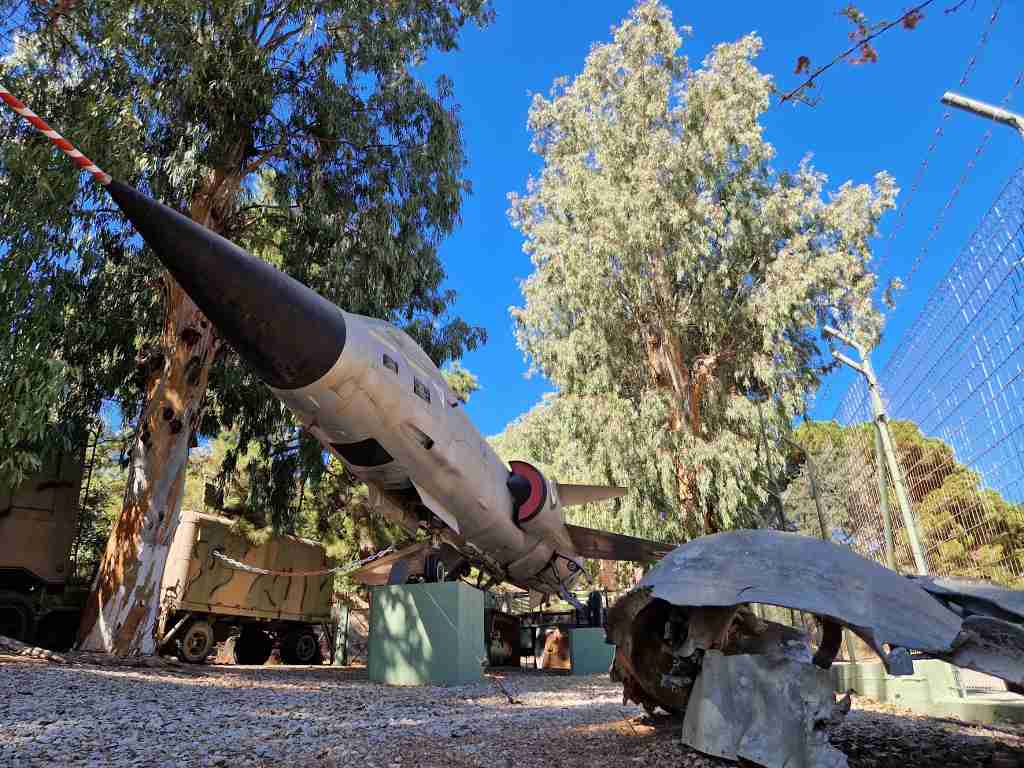
Leros War Museum: The War Museum is located in Lakki and is unique in that it is housed in an old, fully restored military tunnel built by the Italians during WWII. The point of the War Museum of Leros is to showcase the sheer cost of war in life and livelihood.
You will see impressive collections of various war-related artifacts, from guns and helmets to entire vehicles, in the nearby Museum Park. There is also ample photographic material and an audiovisual display of the famous Battle of Leros, which inspired the movie The Guns of Navarone.
War Material Museum (Deposito De Guerra): This remarkable companion to the War Museum is located in Vromolithos village. It has around 3,000 war-related exhibits from Leros’ Venetian Occupation and onwards, with a special focus on WWII and the Battle of Leros.
The Archeological Museum of Leros: Located in Aghia Marina, the Archaeological Museum is housed in a beautiful 19th-century neoclassical building. It is a great place to begin your exploration of Leros’ archaeological treasures. Its collection is small but highly interesting: all of the exhibits were excavated in Leros and its nearby islets. They date from all eras of antiquity, and it’s a great introduction to what there is to see on the island in that respect.
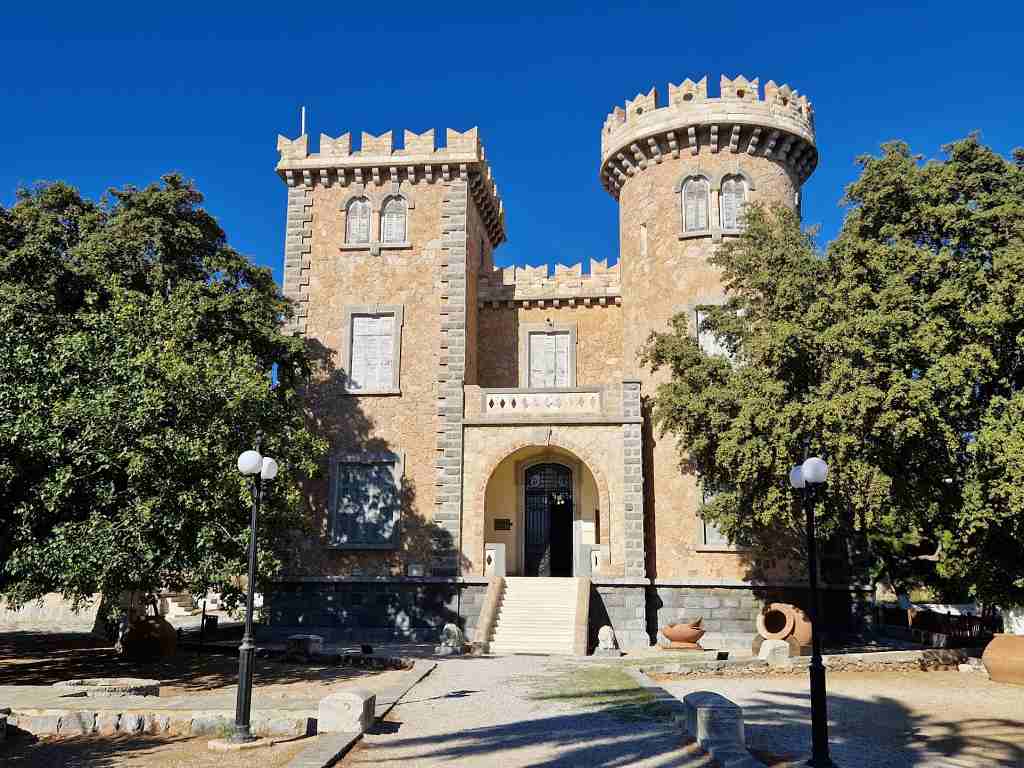
Historical and Folklore Museum (Bellenis Tower): In Alinta village, near the coast and in the lush garden, you will find this museum, which is housed in a gorgeous tower called Bellenis Tower. The Tower was built in the Romanesque and Neogothic styles in 1927.
The Tower itself is enough of a sight, but the museum within is also beautiful and diverse. On the ground floor, you will find folklore exhibits, from costumes and household items to religious utensils and old musical instruments.
On the second floor, there is a room dedicated to the famous painter Kyriakos Tsakiris and the works he created while in exile on the island.
In the next room, there are artifacts from the time that the Tower was used as an army hospital by the Germans. In the next room, you will find remains from the various famous naval battles fought in the waters of Leros, from the Greek War of Independence to the Battle of Leros in WWII.
Visit the churches
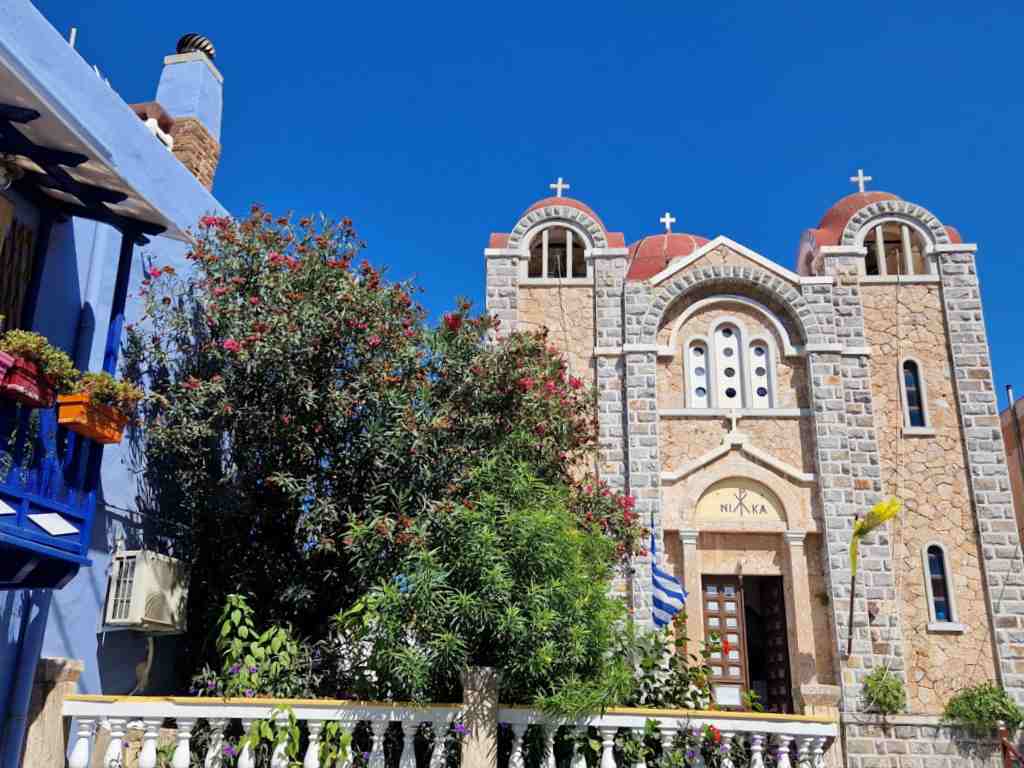
Church of Aghia Marina: Very near the port of Aghia Marina, you will find this large, imposing, beautifully constructed church. Made from black stone from the nearby islet of Levithia and red mosaic rocks from the bay of Kryfo, the sheer craftsmanship of the church will impress you. If you happen to be at Leros in July, on the 17th, there is a huge panigyri (celebration) you shouldn’t miss, with music, dancing, and free food!
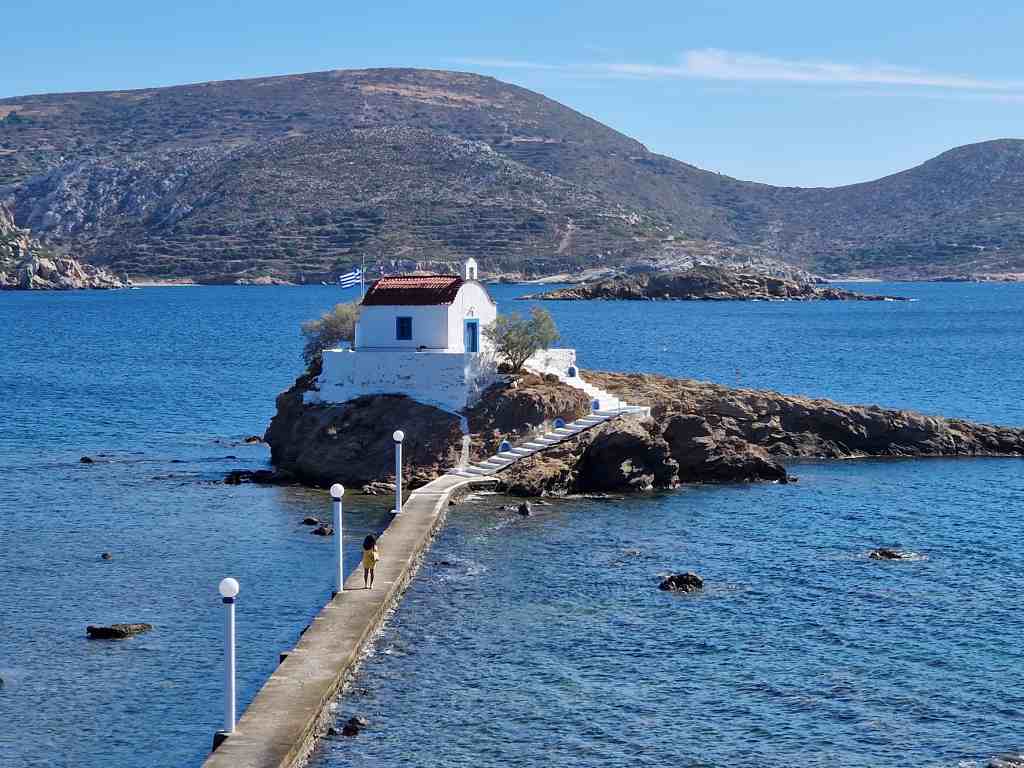
Chapel of Aghios Isidoros: At Alinda, you will find this unique, very picturesque chapel with an unusual location. Follow a thin strip of land over the sea to get to the little church. Behind the church’s altar, you can also see the ruins of an ancient temple. Stick around for a gorgeous sunset!
Church of Panagia Kavouradena: The name of this beautiful little church means “Virgin Mary of the Crabs,” and it is due to the legend of how it was made. According to folklore, there was a fisherman that was gathering shellfish from among the rocks on the shore of Ksirokampos, when he was suddenly bit by a crab.
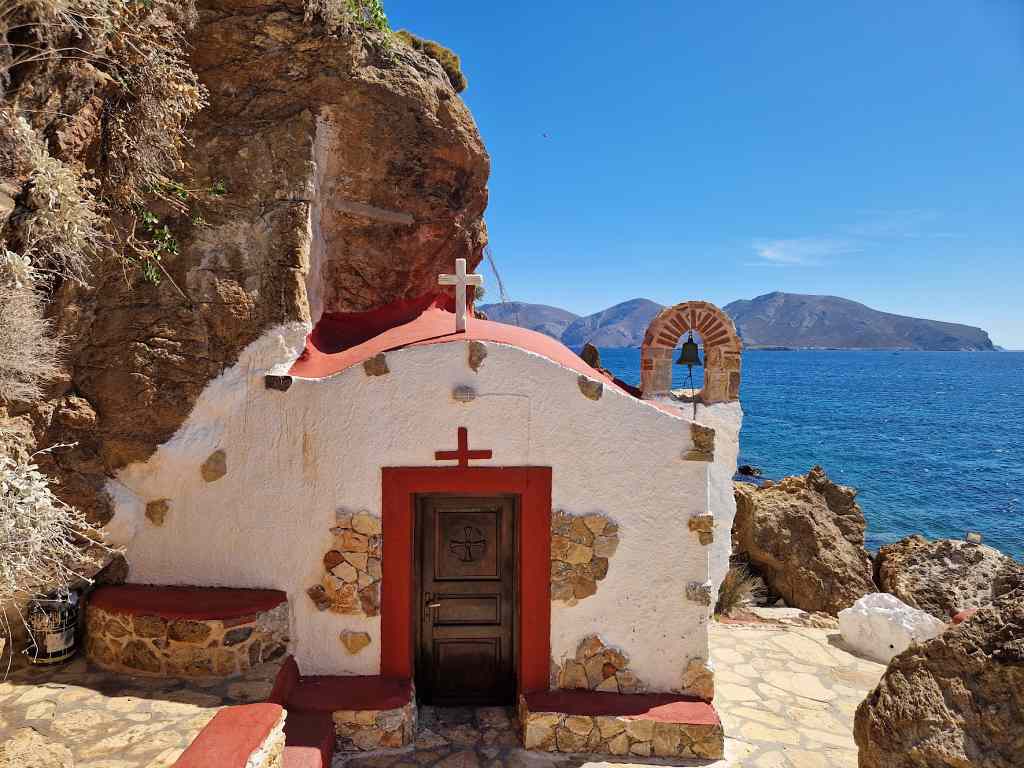
Startled, he looked up and saw an icon of the Virgin Mary among the lapping water. He prayed, going to pick it up, and his wound healed. The fisherman took the icon to town, but at night, he saw a black-clad woman asking him to return the icon where he found it.
Thus, it was decided to build a church where the icon was found to house it. The church itself is beautiful, with a yard with a lush garden and stunning views. The church’s interior incorporates the rocks where the icon was said to be found.
Chapel of Prophet Elias: Right underneath the Castle of Panteli, you will find this beautiful little church. Because churches dedicated to the Prophet Elias are always built at high points, this is the perfect spot to enjoy a beautiful sunset and a sweeping view of the island and the Aegean.
Hit the beaches
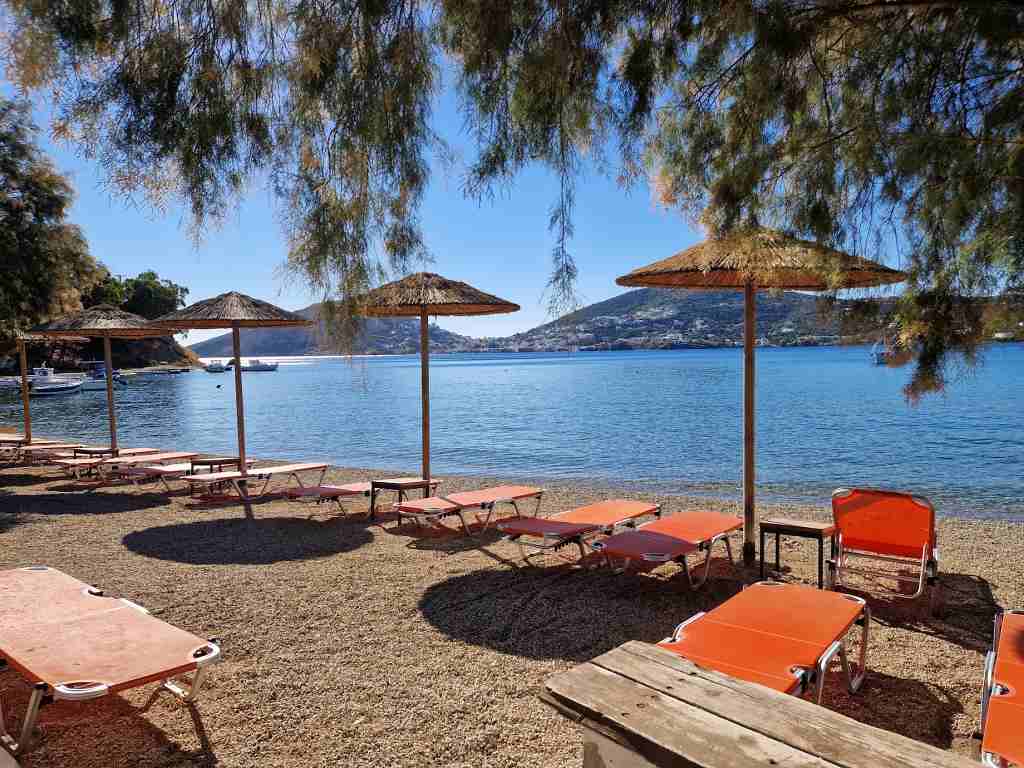
The great thing about the sights in Leros is that almost all of them have gorgeous beaches nearby, so you can go for a swim right after you visit and cool down or relax! Here are some of the best ones:
Alinda Beach: Alinda’s beach is one of the most popular beaches in Leros. Sandy and sunny, it is quite organized so that you will find all the necessary amenities. Keep in mind it gets crowded easily.
Aghia Marina: Yet another popular, organized beach that is right next to Aghia Marina town. The waters are crystal clear, and the shore is pebbled with smooth sand-colored pebbles. Aghia Marina has a lot of restaurants and cafés to refresh yourself after a swim!
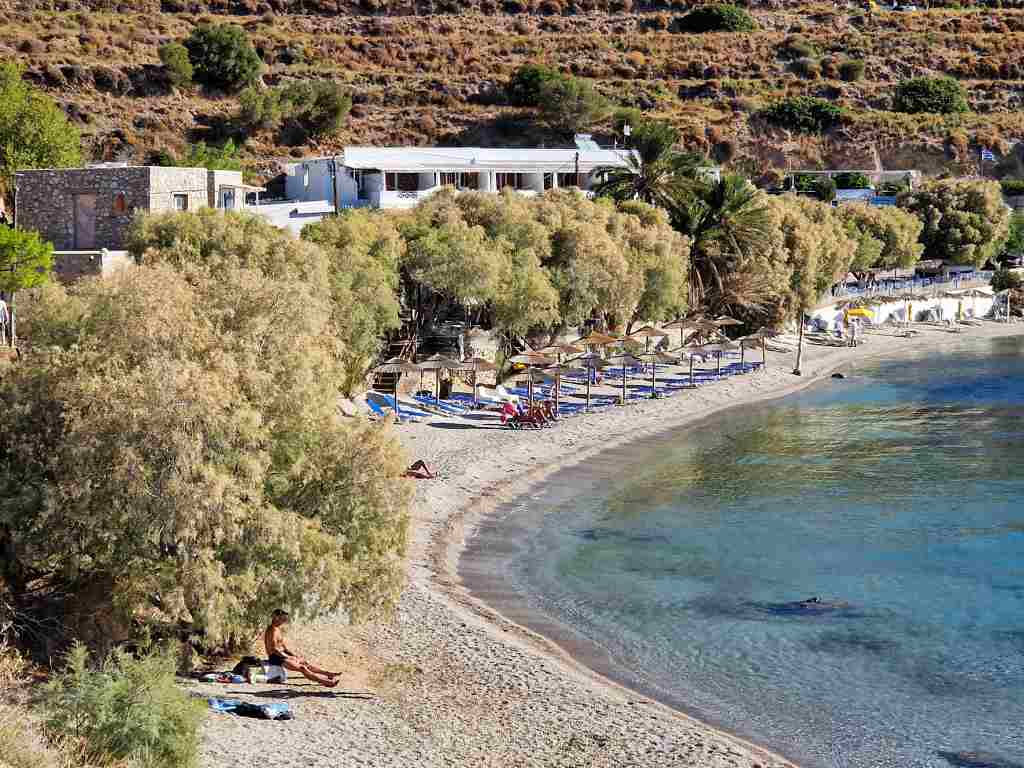
Vromolithos beach: At the village of Vromolithos, you will find a gorgeous pebbly beach where the lush green contrasts beautifully with the blue of the sea. The sea bottom is sandy, and the waters are great for families. There are great fish taverns all around, too.
Dioliskaria Beach: This is a gem that waits for the adventurous. The beach is secluded and can be reached through a trekking path 7 km north of Platanos. Its waters are gorgeous turquoise, and the shore is sandy.
Ksirokambos beach: Very near the Church of Panagia Kavouradena, you will find this little beach perfect for relaxation and pampering, as it is quite organized and has amenities available. The shore is pebbly, and the waters very clear.
Take a day trip to Lipsi Island.
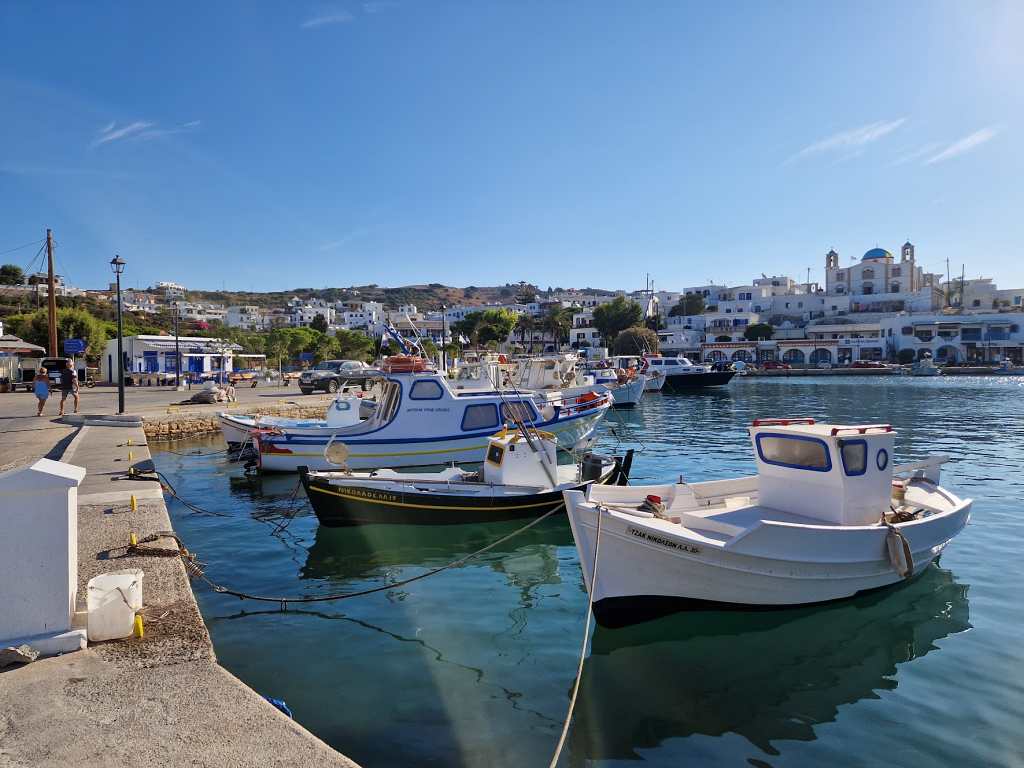
From Leros, you can take a day trip to the nearby Lipsi island, which remains one of the least visited, most authentic islands of the Dodecanese. It has very few roads and even fewer cars, but still, there is a lot to do and visit in a day.
There are gorgeous churches to visit, all with their legend, and most of them house important religious artifacts or art. There are gorgeous beaches to swim in, and above all, Lipsi is known for its fish taverns and ouzeries- ouzo houses where assortments of mezedes, the tidbit food to accompany alcohol, are served. If you’re looking to sample some of the most authentic fisherman village cuisines, Lipsi is the place to do it!
Sample the local food and specialties
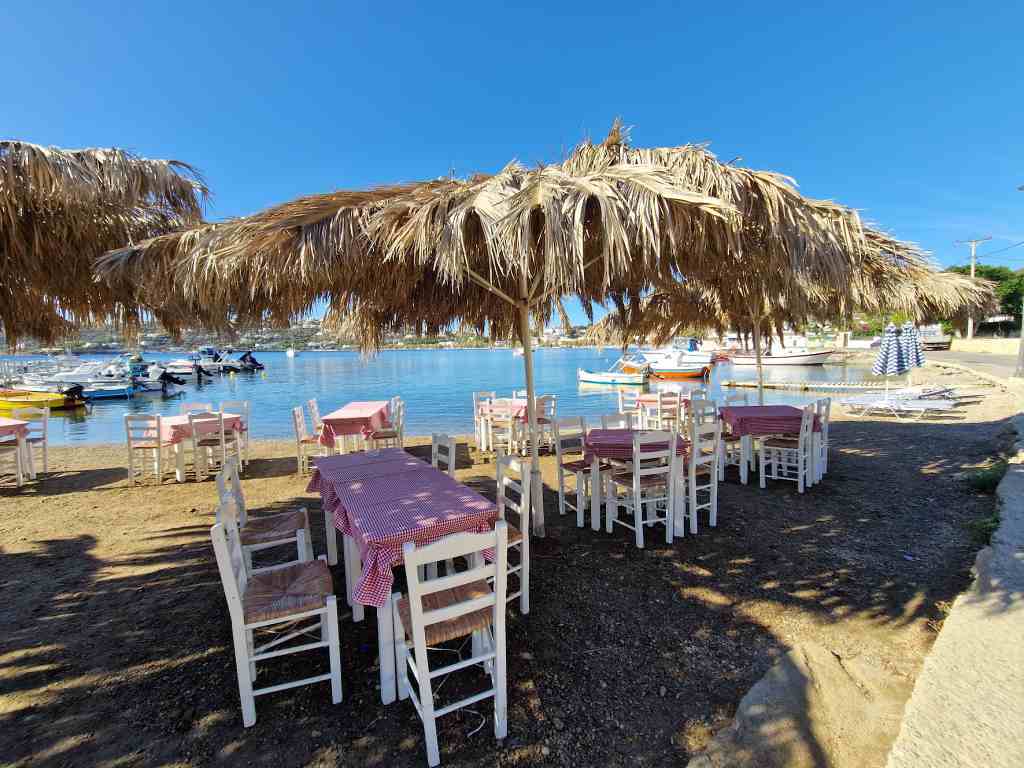
Even if you don’t opt for the Lipsi day trip, Leros is the perfect place for an unforgettable culinary adventure. The island is famous for its fresh fish and good food, so make sure you try the local products, especially the different Lerian cheeses, such as mitzithra and tsitsiri which have a strong, unique taste.
When ordering fresh fish, stray away from the admittedly exquisite- grill and try the local ways of cooking, such as rosemary wine. Try the local honey and the island’s sweet drink, called soumada, which is made from almonds and is traditionally served at weddings. Some of these make for excellent tokens to bring home with you.
Do some scuba diving.
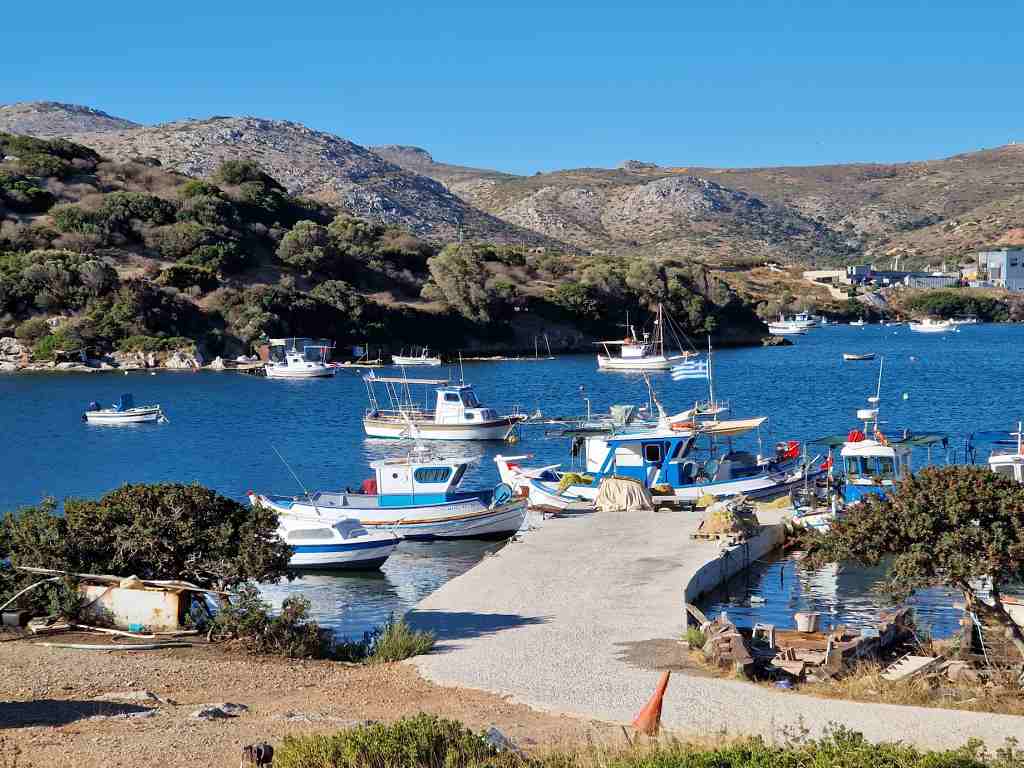
Leros’ underwater landscapes are breathtakingly beautiful, which is why it is quickly becoming a very popular international destination for scuba diving. Especially around its rocky shores and at the site of the submerged Queen Olga Destroyer remains from WWII, you will get to see unique beauty and that special type of tranquility that exists beneath the surface.
There are two diving centers in Leros where you can get courses and equipment or guidance for scuba diving, Leros Diving at Ksirokampos and Hydrovious Diving Center at the village of Krithoni.
Get on an e-bike
If you’re a fan of adventure and want to cover as much of Leros as possible while enriching your experience, then you should explore the island on an e-bike. The e-bike is designed to make it easy to access even the sandy beaches on it, to bike up the slopes of its various hills easily, and get off-road wherever you want, thanks to the bike’s powerful mechanic and motor. Give your vacation a unique feel and help the environment by reducing emissions while you’re at it!
You can rent e-bikes at Leros’ Ebike Rental.
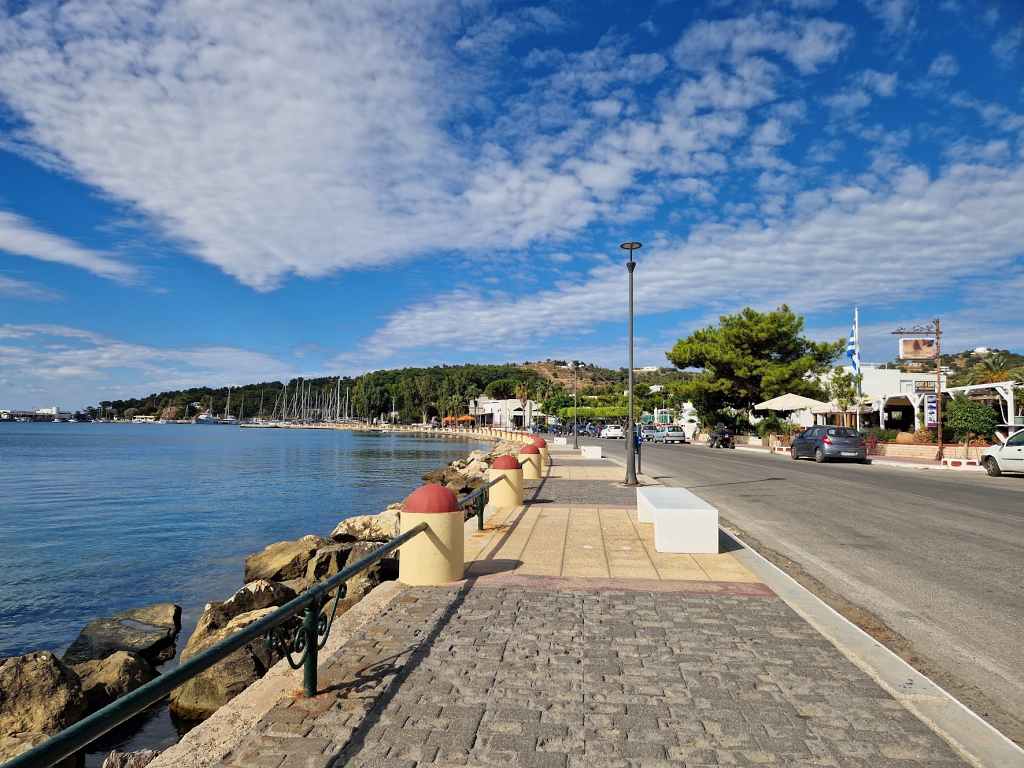
Go hiking
Leros is the perfect island to do some hiking because of its gentle, rolling hills and lush natural landscapes, together with the beautiful blue of the Aegean. There are several hiking trails designed to revolve around a theme so that you can get to know Leros just by hiking on its trails.
Take a trip from antiquity to the drama of WWII or relax on the trail of all its beautiful churches. Or perhaps take the scenic trail that gets you through Leros’ idyllic villages. Or do it all!
Taste the local wine
Leros is known for its fine wine production, so take the opportunity to sample some of its excellent varieties by doing some wine tasting. Visit the Hatzidakis winery for an authentic experience in a family-owned vineyard. Taste the white, red, or sweet wine together with good food, chat with the hosts, and learn how the wine is made together with its history.

